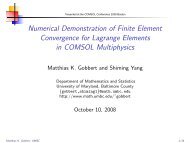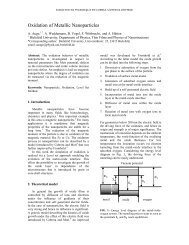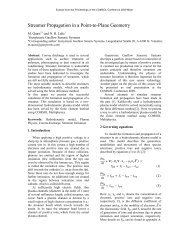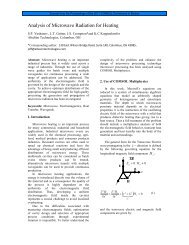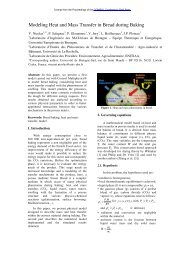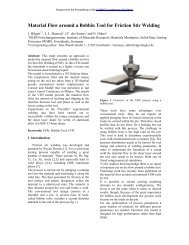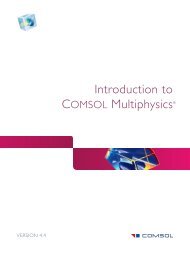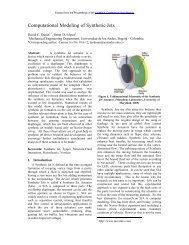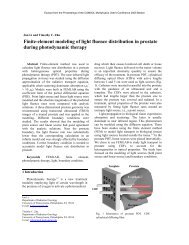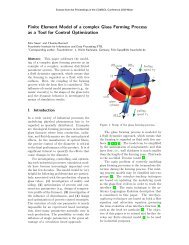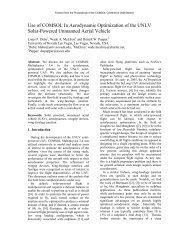Simulation of heat and momentum flow in a quartz mercury ... - Comsol
Simulation of heat and momentum flow in a quartz mercury ... - Comsol
Simulation of heat and momentum flow in a quartz mercury ... - Comsol
- No tags were found...
Create successful ePaper yourself
Turn your PDF publications into a flip-book with our unique Google optimized e-Paper software.
Excerpt from the Proceed<strong>in</strong>gs <strong>of</strong> the COMSOL Multiphysics User's Conference 2005 BostonThe doma<strong>in</strong> <strong>in</strong>cludes two electrodes withproperties <strong>of</strong> tungsten, an arc tube with properties <strong>of</strong><strong>quartz</strong>, <strong>and</strong> an enclosed gas with properties <strong>of</strong><strong>mercury</strong> vapor.A mesh <strong>of</strong> 2484 first-order Lagrangian elementsis used <strong>and</strong> shown <strong>in</strong> Figure 2. Ref<strong>in</strong>ement aroundthe electrodes is needed to help assure convergence,as the spatial temperature gradients are steepest there.Figure 2: Mesh for the gas, electrodes, <strong>and</strong> arctubeSome approximations are used here to simplifythe problem:• Although HID lamps run on alternat<strong>in</strong>gcurrent, the FEMLAB model isconstructed for direct current so that asteady simulation can be performed.• Radiation is characterized as a localtemperature-dependent loss term <strong>in</strong> theElenbaas-Heller (energy) equation. Thenon-local effect <strong>of</strong> absorption isneglected <strong>in</strong> the model.• Heat transfer between the gas <strong>and</strong> theelectrodes is mischaracterized <strong>in</strong> themodel as pure <strong>heat</strong> conduction. In HIDlamps, there is a non-neutral plasmas<strong>heat</strong>h near each electrode <strong>in</strong> whichmany more processes govern the <strong>heat</strong>transfer – all <strong>of</strong> these additionalprocesses are neglected <strong>in</strong> the model.• Spatial pressure variation is <strong>in</strong>corporatedfor buoyancy, but neglected <strong>in</strong> the idealgas law.• Although compressibility is <strong>in</strong>cluded <strong>in</strong>the mass cont<strong>in</strong>uity equation, it isneglected <strong>in</strong> the viscous stress terms <strong>of</strong>the <strong>momentum</strong> equations. We assumethat stresses associated with dilitation aresmall compared with stresses associatedwith shear.The ma<strong>in</strong> aspects <strong>of</strong> the mathematical formulation<strong>of</strong> the problem are as follows: The govern<strong>in</strong>gequations are those <strong>of</strong> natural convection coupledwith <strong>heat</strong> transfer <strong>and</strong> electrical current cont<strong>in</strong>uity 2,3,4 .For velocity vector u r , gas density ρ , <strong>and</strong> pressurep , the steady <strong>momentum</strong> equations <strong>in</strong> the radial ( r )<strong>and</strong> vertical ( z ) directions are expressed <strong>in</strong> vectorform asr r r r r r r rρu ∇ u =− ∇{p −{ρg +∇ ( μ∇u).123 14243 (1)convectionpressuregradientbuoyancyviscous stressThe steady, compressible mass cont<strong>in</strong>uity equation isr r∇ ( ρu ) = 0.(2)Velocity boundary conditions are no-slip <strong>and</strong>impermiability at all solid surfaces, <strong>and</strong> naturalsymmetry conditions along the axis. Because thespatial pressure variation is smaller than the lamppressure by 5 orders <strong>of</strong> magnitude, pressure isassumed to be contant <strong>in</strong> the ideal gas law which thenpecomesρ T = constant.(3)For electrical potential φ <strong>and</strong> temperature T , theenergy balance <strong>in</strong> the gas is expressed by theElenbaas-Heller equation:r r r r rρcu∇ T=∇ κ∇ T + σ ∇φ− q2( ) {radp14243 14243 123convection conduction electrical<strong>heat</strong> sourceradiation<strong>heat</strong> s<strong>in</strong>k(4)Heat also conducts through the arc tube <strong>and</strong>electrodes with the steady <strong>heat</strong>-condcution equation,us<strong>in</strong>g thermal conductivities that are appropriate to<strong>quartz</strong> <strong>and</strong> tungsten respectively. Heat leaves thesystem with the Stefan-Boltzmann law as theboundary condition on the outer arc-tube surface. Asmall amount <strong>of</strong> <strong>heat</strong> also conducts away from theouter electrode ends, us<strong>in</strong>g a semi-empirical mixedboundary condition. The source <strong>and</strong> s<strong>in</strong>k terms <strong>of</strong>Eq. (4) are very strong functions <strong>of</strong> temperature,because <strong>of</strong> the temperature dependence <strong>of</strong> electricalconductivity σ <strong>and</strong> volumetric radiation qrad. For apure <strong>mercury</strong> lamp runn<strong>in</strong>g at 3.78 atm <strong>of</strong> pressure,these terms are approximated <strong>in</strong> the model with thefollow<strong>in</strong>g semi-empirical expressions: 50.75 −55820/Tσ = 1070 T e ,142.69×10(5)−86000/Tq = e .radTThe electrical potential φ (which is also voltage) isdeterm<strong>in</strong>ed from the current cont<strong>in</strong>uity equation



